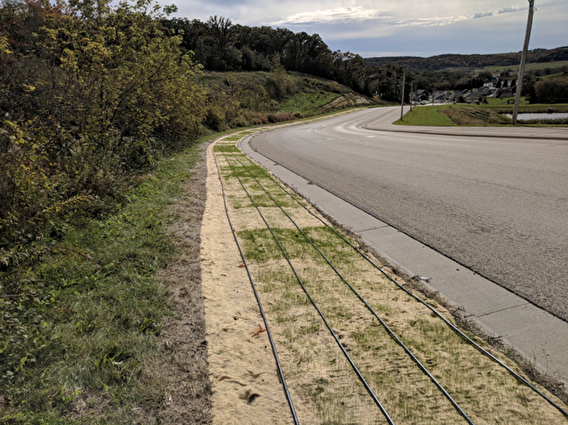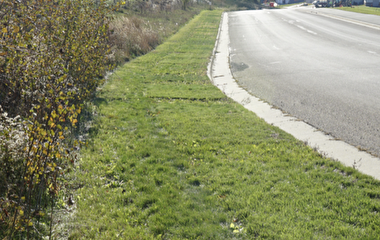
Traditional practices for planting and maintaining roadside turfgrass in Minnesota have generally focused on finding a few plant species that do well in combination and blanket-prescribing them across the state. A recent U of M study, however, finds that plantings tend to do better when they are both biodiverse and carefully matched to their ideal growing conditions.
Roadside turfgrass serves the important roles of reducing soil erosion, pollutant runoff, and the spread of invasive weeds, as well as adding visual appeal. Maintaining it in Minnesota, however, is difficult because of the harsh climate and maintenance practices (such as salting and plowing).
A team of U of M researchers set out to find a more stable, cost-effective approach to establishing roadside turfgrass vegetation.
“Developing tools for practitioners to make better decisions on revegetating roadsides will save financial resources for MnDOT, practitioners, and local communities,” says Eric Watkins, professor with the Department of Horticultural Science and principal investigator for the project.
The researchers set up 14 test plots along Minnesota roadways and tested 44 treatments— some monocultures and some mixes. What they found matched up with existing literature from other systems: Biodiversity correlates to better vegetation cover and a decrease in weeds.
“The use of species mixtures, compared to monocultures, has been shown to have multiple benefits,” Watkins says. “These include more coverage of the seeded species, reduced disease frequency and severity, and extended green color.”
The reason this happens, Watkins explains, is likely because within the diverse species mix, the plants have a variety of adaptations and tolerances and can survive a wider array of conditions than a single species could.
The immediate downside of biodiversity, Watkins says, is the complicated nature of it. Every plant species and subspecies can have wildly different germination rates, rooting depths, and moisture and temperature tolerances; interaction among species can change things even further.
To make it easier for practitioners to implement biodiverse seed mixes, the researchers broke Minnesota into three “seeding clusters”—regions based on growing conditions such as temperature, moisture, and soil quality. Two of the seeding clusters are geographic (north Minnesota and central/south Minnesota), and the third is categorized as “poor soil quality” (soil that is sandy, low in organic matter, etc.).
“Establishing these test plots with seed mixes that vary by region was an important step in finding the most effective and climate-resistant roadside turfgrass,” says Dwayne Stenlund, erosion control specialist with MnDOT’s Erosion Control and Stormwater Management unit and the study’s technical liaison.
The researchers then designed an Excel budgeting tool that local and state officials can use to determine which plant species will be most cost-effective for a given site. The tool takes factors such as the cost of labor, water, seed, and maintenance into account as well as the predicted performance of a given seed mix.
Moving forward, Watkins says, the researchers plan to make a web-based version of the budgeting tool so it’s easier for local agencies and MnDOT to use. They also plan to do more long-term studies at the test plots (the current studies only ran two years), and future seed testing will need to take climate change into account.
“Implementing these mixtures will reduce soil erosion, improve aesthetics, save local communities’ financial resources, and improve the overall environment we occupy,” Watkins says.
The project was funded by the Minnesota Local Road Research Board.
Writer: Sophie Koch


